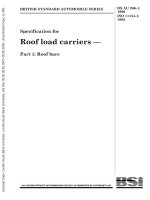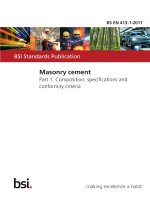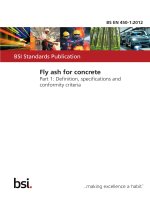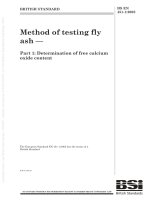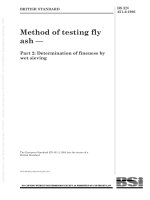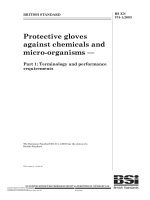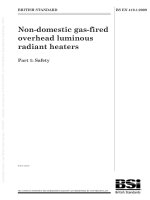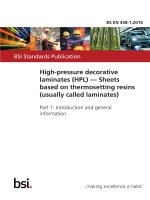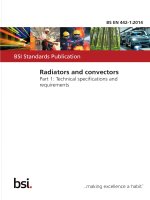Bsi bs en 26157 1 1992 (1999)
Bạn đang xem bản rút gọn của tài liệu. Xem và tải ngay bản đầy đủ của tài liệu tại đây (685.83 KB, 18 trang )
Licensed copy: The University of Hong Kong, The University of Hong Kong, Version correct as of 27/11/2008 07:44, (c)
BSI
BRITISH STANDARD
Fasteners — Surface
discontinuities —
Part 1: Bolts, screws and studs for
general requirements
The European Standard EN 26157-1:1991 has the status of a
British Standard
BS EN
26157-1:1992
ISO 6157-1:
1988
Licensed copy: The University of Hong Kong, The University of Hong Kong, Version correct as of 27/11/2008 07:44, (c)
BSI
BS EN 26157-1:1992
This British Standard, having
been prepared under the
direction of the General
Mechanical Engineering
Standards Policy Committee,
was published under the
authority of the Standards
Board and comes
into effect on
1 May 1992
© BSI 08-1999
The following BSI references
relate to the work on this
standard:
Committee reference GME/9
Draft announced in BSI News
December 1991
ISBN 0 580 20813 3
Cooperating organizations
The European Committee for Standardization (CEN), under whose supervision
this European Standard was prepared, comprises the national standards
organizations of the following countries:
Austria
Belgium
Denmark
Finland
France
Germany
Greece
Iceland
Ireland
Italy
Luxembourg
Netherlands
Norway
Portugal
Spain
Sweden
Switzerland
United Kingdom
Oesterreichisches Normungsinstitut
Institut belge de normalisation
Dansk Standardiseringsraad
Suomen Standardisoimisliito, r.y.
Association franỗaise de normalisation
Deutsches Institut fỹr Normung e.V.
Hellenic Organization for Standardization
Technological Institute of Iceland
National Standards Authority of Ireland
Ente Nazionale Italiano di Unificazione
Inspection du Travail et des Mines
Nederlands Normalisatie-instituut
Norges Standardiseringsforbund
Instituto Portugs da Qualidade
Asociación Espola de Normalización y Certificación
Standardiseringskommissionen i Sverige
Association suisse de normalisation
British Standards Institution
Amendments issued since publication
Amd. No.
Date
Comments
Licensed copy: The University of Hong Kong, The University of Hong Kong, Version correct as of 27/11/2008 07:44, (c)
BSI
BS EN 26157-1:1992
Contents
Cooperating organizations
National foreword
Foreword
Text of EN 26157-1
National annex NA (informative) Committees responsible
National annex NB (informative) Cross-references
© BSI 08-1999
Page
Inside front cover
ii
2
3
Inside back cover
Inside back cover
i
Licensed copy: The University of Hong Kong, The University of Hong Kong, Version correct as of 27/11/2008 07:44, (c)
BSI
BS EN 26157-1:1992
ii
National foreword
This British Standard has been prepared under the direction of the General
Mechanical Engineering Standards Policy Committee and is the English
language version of EN 26157-1:1991, “Fasteners — Surface discontinuities —
Part 1: Bolts, screws and studs for general requirements’, published by the
European Committee for Standardization (CEN). It is identical with
ISO 6157-1:1988, published by the International Organization for
Standardization (ISO). EN 26157-1:1991 was produced as a result of
international discussion in which the UK took an active part.
A British Standard does not purport to include all the necessary provisions of a
contract. Users of British Standards are responsible for their correct application.
Compliance with a British Standard does not of itself confer immunity
from legal obligations.
Summary of pages
This document comprises a front cover, an inside front cover, pages i and ii,
the EN title page, pages 2 to 12, an inside back cover and a back cover.
This standard has been updated (see copyright date) and may have had
amendments incorporated. This will be indicated in the amendment table on the
inside front cover.
© BSI 08-1999
Licensed copy: The University of Hong Kong, The University of Hong Kong, Version correct as of 27/11/2008 07:44, (c)
BSI
EUROPEAN STANDARD
EN 26157-1
NORME EUROPÉENNE
October 1991
EUROPÄISCHE NORM
UDC 621.882.2:620.191
Descriptors: Fasteners, bolts, screws, studs, surface defects
English version
Fasteners — Surface discontinuities —
Part 1: Bolts, screws and studs for general requirements
(ISO 6157-1:1988)
Eléments de fixation — Défauts de surface —
Partie 1: Boulons, vis et goujons d’usage
général
(ISO 6157-1:1988)
Verbindungselemente — Oberflächenfehler —
Teil 1: Schrauben für allgemeine
Anforderungen
(ISO 6157-1:1988)
www.bzfxw.com
This European Standard was approved by CEN on 1991-10-10. CEN members
are bound to comply with the CEN/CENELEC Internal Regulations which
stipulate the conditions for giving this European Standard the status of a
national standard without any alteration.
Up-to-date lists and bibliographical references concerning such national
standards may be obtained on application to the Central Secretariat or to any
CEN member.
This European Standard exists in three official versions (English, French,
German). A version in any other language made by translation under the
responsibility of a CEN member into its own language and notified to the
Central Secretariat has the same status as the official versions.
CEN members are the national standards bodies of Austria, Belgium,
Denmark, Finland, France, Germany, Greece, Iceland, Ireland, Italy,
Luxembourg, Netherlands, Norway, Portugal, Spain, Sweden, Switzerland and
United Kingdom.
CEN
European Committee for Standardization
Comité Européen de Normalisation
Europäisches Komitee für Normung
Central Secretariat: rue de Stassart 36, B-1050 Brussels
© CEN 1991 Copyright reserved to all CEN members
Ref. No. EN 26157-1:1991 E
Licensed copy: The University of Hong Kong, The University of Hong Kong, Version correct as of 27/11/2008 07:44, (c)
BSI
EN 26157-1:1991
Foreword
Contents
In 1990, ISO 6157-1:1988 was submitted to the
CEN P.Q.-procedure.
Following the positive result of the P.Q., CEN/BT
agreed to submit ISO 6157-1:1988 with the
following modifications to Formal Vote.
In the French version, replace:
— “boulon” by “vis”
— “boulon, vis” by “vis”
In accordance with the Common CEN/CENELEC
Rules, the following countries are bound to
implement this European Standard: Austria,
Belgium, Denmark, Finland, France, Germany,
Greece, Iceland, Ireland, Italy, Luxembourg,
Netherlands, Norway, Portugal, Spain, Sweden,
Switzerland, and United Kingdom.
Foreword
1
Scope and field of application
2
References
3
Types, causes, appearance and limits
of surface discontinuities
4
Inspection and evaluation procedure
Annex Sampling plan for surface
discontinuities
Table 1 — Samples sizes for visual
and non-destructive testing
Table 2 — Secondary sample sizes for
destructive testing
2
Page
2
3
3
3
10
11
11
11
www.bzfxw.com
© BSI 08-1999
Licensed copy: The University of Hong Kong, The University of Hong Kong, Version correct as of 27/11/2008 07:44, (c)
BSI
EN 26157-1:1991
1 Scope and field of application
1.1 This part of ISO 6157 establishes limits for various types of surface discontinuities on bolts, screws and
studs for general requirements.
It applies to bolts, screws and studs with
— nominal thread diameters 5 mm and larger;
— product grades A and B;
— property classes up to and including 10.9, unless otherwise specified in product standards or agreed
between supplier and purchaser.
1.2 Limits for surface discontinuities on bolts, screws and studs for special requirements (e.g. automatic
assembly) are laid down in ISO 6157-3. When the engineering requirements of the application necessitate
that surface discontinuities on bolts, screws and studs be more closely controlled, it should be specified in
the respective product standard, or the purchaser shall specify the applicable limits in the inquiry and
purchase order.
1.3 Where the permissible limits for surface discontinuities indicated in clause 3 occur, the minimum
values for the mechanical and functional properties specified in ISO 898-1 should still be met.
NOTE 1
NOTE 2
The figures in clause 3 are examples only. They apply correspondingly also to other types of bolts, screws and studs.
The individual figures show the surface discontinuities exaggerated in some cases for clarity.
2 References
ISO 468, Surface roughness — Parameters, their values and general rules for specifying requirements.
ISO 898-1, Mechanical properties of fasteners — Part 1: Bolts, screws and studs.
ISO 2859, Sampling procedures and tables for inspection by attributes.
ISO 3269, Fasteners — Acceptance inspection.
www.bzfxw.com
3 Types, causes, appearance and limits of surface discontinuities
3.1 Cracks
A crack is a clean (crystalline) fracture passing through or across the grain boundaries and may possibly
follow inclusions of foreign elements. Cracks are normally caused by overstressing the metal during forging
or other forming operations, or during heat treatment. Where parts are subjected to significant reheating,
cracks usually are discoloured by scale.
© BSI 08-1999
3
Licensed copy: The University of Hong Kong, The University of Hong Kong, Version correct as of 27/11/2008 07:44, (c)
BSI
EN 26157-1:1991
3.1.1 Quench cracks
Cause
Quench cracks may occur during hardening due to excessively high thermal and
transformation stresses. Quench cracks usually follow an irregular and erratic course on
the surface of the fastener.
Appearance
Limits
www.bzfxw.com
Quench cracks of any depth, any length, or in any location are not permitted.
3.1.2 Forging cracks
Cause
Forging cracks may occur during the cut-off or forging operations and are located on the
top of the head of screws and bolts and on the raised periphery of indented head bolts and
screws.
Appearance
Limits
4
Length, l, of forging cracks: l u da
Depth or width, b, of forging cracks: b u 0,04 d
ad
= nominal thread diameter
© BSI 08-1999
Licensed copy: The University of Hong Kong, The University of Hong Kong, Version correct as of 27/11/2008 07:44, (c)
BSI
EN 26157-1:1991
3.1.3 Forging bursts
Cause
Forging bursts may occur for example during forging on the flats or corners of the heads
of bolts and screws, at the periphery of flanged or circular head products or on the raised
periphery of indented head bolts and screws.
Appearance
Limits
Hexagon head screws
www.bzfxw.com
No forging burst in the flats of hexagon bolts and screws shall extend into the crown circle
on the top of the head surface (chamfer circle) or into the underhead bearing surface.
Forging bursts occurring at the intersection of two wrenching flats shall not reduce the
width across corners below the specified minimum.
Forging bursts in the raised periphery of indented head bolts and screws shall not exceed
a width of 0,06da or have a depth extending below the indented portion.
Circular head screws
Flanges of bolts and screws and peripheries of circular head screws may have forging
bursts, but they shall not exceed the following limits:
Width of forging bursts:
0,08dcb (with only one forging burst);
0,04dc (with two or more forging bursts, one of which may extend to 0,08dc).
© BSI 08-1999
a
d = nominal thread diameter
b
dc = head or flange diameter
5
Licensed copy: The University of Hong Kong, The University of Hong Kong, Version correct as of 27/11/2008 07:44, (c)
BSI
EN 26157-1:1991
3.1.4 Shear bursts
Cause
Shear bursts may occur, for example during forging, frequently at the periphery of
products having circular or flanged heads, and are located at approximately 45° to the
product axis.
Shear bursts may also occur on the sides of hexagon head products.
Appearance
Limits
6
Hexagon head screws
www.bzfxw.com
No shear burst in the flats of hexagon bolts and screws shall extend into the crown circle
on the top of the head surface (chamfer circle) or into the underhead bearing surface.
Shear bursts, occurring at the intersection of two wrenching flats, shall not reduce the
width across corners below the specified minimum.
Shear bursts in the raised periphery of indented head bolts and screws shall not exceed a
width of 0,06da or have a depth extending below the indented portion.
Circular head screws
Flanges of bolts and screws and peripheries of circular head products may have shear
bursts, but shall not exceed the following limits:
Width of shear bursts:
0,08dcb (for only one shear burst);
0,04dc (with two or more forging shear bursts, one of which may extend to 0,08dc).
a
d
b
= nominal thread diameter
dc = head or flange diameter
© BSI 08-1999
Licensed copy: The University of Hong Kong, The University of Hong Kong, Version correct as of 27/11/2008 07:44, (c)
BSI
EN 26157-1:1991
3.2 Raw material seams and laps
A seam or lap is a narrow, generally straight or smooth curved line discontinuity running longitudinally
on the thread, shank or head.
Cause
Seams and laps are inherent in the raw material from which fasteners are made.
Appearance
www.bzfxw.com
Limits
Permissible depth: 0,03da
If laps or seams extend into the head, they shall not exceed the permissible limits for
width and depth specified for bursts (see 3.1.3).
ad
© BSI 08-1999
= nominal thread diameter
7
Licensed copy: The University of Hong Kong, The University of Hong Kong, Version correct as of 27/11/2008 07:44, (c)
BSI
EN 26157-1:1991
3.3 Voids
A void is a shallow pocket or hollow on the surface of a bolt or screw due to non-filling of metal during
forging or upsetting.
Cause
Voids are produced by marks and impressions due to chips (shear burrs) or by rust
formation on the raw material. They are not eliminated during forging or upsetting
operations.
Appearance
Limits
8
Depth, h, of voids:
www.bzfxw.com
h u 0,02 da: 0,25 mm max.
Area of all voids:
The combined surface area of all voids on the bearing face shall not exceed 10 % of the
total area.
a
d = nominal thread diameter
© BSI 08-1999
Licensed copy: The University of Hong Kong, The University of Hong Kong, Version correct as of 27/11/2008 07:44, (c)
BSI
EN 26157-1:1991
3.4 Folds
A fold is a doubling over of metal which occurs at the surface of the fastener during forging.
Cause
Folds are produced by material displacements due to lack of congruence of forms and
volumes of the single forging steps.
Appearance
www.bzfxw.com
Limits
Folds at interior corners at or below the bearing surface are not permissible, unless
specifically permitted in this part of ISO 6157 or in the product standard.
Folds at exterior corners are permissible.
3.5 Tool marks
Tool marks are longitudinal or circumferential grooves of shallow depth.
Cause
Tool marks are produced by the movement of manufacturing tools over the surface of the
bolt or screw.
Appearance
Limits
© BSI 08-1999
Tool marks produced by machining in the shank, fillet or bearing surface shall not exceed
a surface roughness of Ra = 3,2 4m when tested in accordance with ISO 468.
9
Licensed copy: The University of Hong Kong, The University of Hong Kong, Version correct as of 27/11/2008 07:44, (c)
BSI
EN 26157-1:1991
3.6 Damages
Damages are indentations of any surface of a bolt or screw.
Cause
Damages, for example dents, scrapes, nicks and gouges, are produced by external action
during manufacture and handling of bolts and screws, for example during loading.
Appearance No precise geometrical shape, location or direction, identifiable as external action.
Limits
Damages as described above shall not cause rejection unless it can be shown that they
impair function or usability.
Dents, scrapes, nicks and gouges on the first three threads shall be such that they allow
the screwing on of a go-ring gauge with torque values of 0,001 d3 max., in newton metres.
4 Inspection and evaluation procedure
For the acceptance inspection procedure, see ISO 3269. Surface coatings shall be removed before
examination if identification of the surface discontinuities is impaired.
NOTE The 1984 edition of ISO 3269 gives no specifications on sampling plans for surface discontinuities of fasteners. Until this has
been completed, the applicable sampling plan is given in the Annex.
4.1 Principles
The manufacturer is entitled to use any inspection procedures but due care shall be taken to ensure that
products conform to this part of ISO 6157.
The purchaser may use the inspection procedure specified in this clause at his acceptance inspection in
order to decide whether a lot of fasteners may be accepted or rejected. This procedure shall also be applied
when conformance to specification is disputed, unless some other acceptance procedure has been agreed
between the manufacturer and the purchaser at the time of ordering the fasteners.
4.2 Non-destructive testing
www.bzfxw.com
A random sample shall be taken from the lot in accordance with Table 1 in the Annex and subjected to
either visual tests or other suitable tests, e.g. magnetic techniques or eddy current. If no defective product
is found the lot shall be accepted (see also 4.4). If defective products are found these shall form the lot size
for the procedures given in 4.3.
4.3 Destructive testing
If defective products are detected by the procedures given in 4.2, then a secondary sample shall be taken
from the defective products, in accordance with Table 2 in the Annex, consisting of the products indicating
the most serious defects and sectioned at 90° through the discontinuity where the greatest depth is
expected.
4.4 Evaluation
If on visual inspection any product is found with quench cracks in any location, or folds at interior corners
or below the bearing surface, except “clover leaf” folds in non-circular shoulder fasteners, the lot shall be
subject to rejection.
If on the destructive test any product is found with forging cracks, bursts, seams and laps, voids, tool marks
or damages which exceed the allowable limits as specified for the applicable type of discontinuity, the lot
shall be subject to rejection.
10
© BSI 08-1999
Licensed copy: The University of Hong Kong, The University of Hong Kong, Version correct as of 27/11/2008 07:44, (c)
BSI
EN 26157-1:1991
Annex Sampling plan for surface discontinuities
(This annex forms an integral part of this standard.)
Sampling for surface discontinuities shall be carried out using the sample sizes given in Table 1 and using
the principles and procedures given in clause 4.
Table 1 — Sample sizes for visual and
non-destructive testing
Lot sizea
N
N u 1 200
1 201 u N u 10 000
10 001 u N u 35 000
35 001 u N u 150 000
Sample size
n
20
32
50
80
NOTE The sample sizes are based on inspection level S-4
specified in IS0 2859.
a
Lot size is the number of products of the same type, size
and property class submitted for inspection at one time.
Table 2 — Secondary sample sizes for
destructive testing
Number of defective products
in the sample
N
Nu 8
9 u N u 15
16 u N u 25
26 u N u 50
51 u N u 80
Secondary sample
size
n
2
3
5
8
13
www.bzfxw.com
NOTE The secondary sample sizes are based on general
inspection level II specified in IS0 2859.
© BSI 08-1999
11
Licensed copy: The University of Hong Kong, The University of Hong Kong, Version correct as of 27/11/2008 07:44, (c)
BSI
12
www.bzfxw.com
blank
Licensed copy: The University of Hong Kong, The University of Hong Kong, Version correct as of 27/11/2008 07:44, (c)
BSI
BS EN 26157-1:1992
National annex NA (informative)
Committees responsible
The United Kingdom participation in the preparation of this European Standard was entrusted by the
General Mechanical Engineering Standards Policy Committee (GME/-) to Technical Committee GME/9,
upon which the following bodies were represented:
BEAMA Ltd.
British Constructional Steelwork Association Ltd.
British Industrial Fasteners’ Federation
British Railways Board
British Steel Industry
British Steel Industry (Wire Section)
Gauge and Tool Makers’ Association
Ministry of Defence
Society of Motor Manufacturers and Traders Ltd.
Washer Manufacturers’ Association of Great Britain
The following bodies were also represented in the drafting of the standard, through subcommittees and
panels:
British Turned-parts Manufacturers’ Association
EEA (The Electronic and Business Equipment Association)
Institute of Metal Finishing
Metal Finishing Association
Stainless Steel Fabricators’ Association of Great Britain
www.bzfxw.com
National annex NB (informative)
Cross-references
Publication referred to
Corresponding British Standard
ISO 898-1:1988
BS EN 20898 Mechanical properties of fasteners
Part 1:1992 Bolts, screws and studs
© BSI 08-1999
Licensed copy: The University of Hong Kong, The University of Hong Kong, Version correct as of 27/11/2008 07:44, (c)
BSI
BS EN
26157-1:1992
ISO 6157-1:
1988
BSI
389 Chiswick High Road
London
W4 4AL
BSI — British Standards Institution
BSI is the independent national body responsible for preparing
British Standards. It presents the UK view on standards in Europe and at the
international level. It is incorporated by Royal Charter.
Revisions
British Standards are updated by amendment or revision. Users of
British Standards should make sure that they possess the latest amendments or
editions.
It is the constant aim of BSI to improve the quality of our products and services.
We would be grateful if anyone finding an inaccuracy or ambiguity while using
this British Standard would inform the Secretary of the technical committee
responsible, the identity of which can be found on the inside front cover.
Tel: 020 8996 9000. Fax: 020 8996 7400.
BSI offers members an individual updating service called PLUS which ensures
that subscribers automatically receive the latest editions of standards.
Buying standards
Orders for all BSI, international and foreign standards publications should be
addressed to Customer Services. Tel: 020 8996 9001. Fax: 020 8996 7001.
In response to orders for international standards, it is BSI policy to supply the
BSI implementation of those that have been published as British Standards,
unless otherwise requested.
Information on standards
www.bzfxw.com
BSI provides a wide range of information on national, European and
international standards through its Library and its Technical Help to Exporters
Service. Various BSI electronic information services are also available which give
details on all its products and services. Contact the Information Centre.
Tel: 020 8996 7111. Fax: 020 8996 7048.
Subscribing members of BSI are kept up to date with standards developments
and receive substantial discounts on the purchase price of standards. For details
of these and other benefits contact Membership Administration.
Tel: 020 8996 7002. Fax: 020 8996 7001.
Copyright
Copyright subsists in all BSI publications. BSI also holds the copyright, in the
UK, of the publications of the internationalstandardization bodies. Except as
permitted under the Copyright, Designs and Patents Act 1988 no extract may be
reproduced, stored in a retrieval system or transmitted in any form or by any
means – electronic, photocopying, recording or otherwise – without prior written
permission from BSI.
This does not preclude the free use, in the course of implementing the standard,
of necessary details such as symbols, and size, type or grade designations. If these
details are to be used for any other purpose than implementation then the prior
written permission of BSI must be obtained.
If permission is granted, the terms may include royalty payments or a licensing
agreement. Details and advice can be obtained from the Copyright Manager.
Tel: 020 8996 7070.
